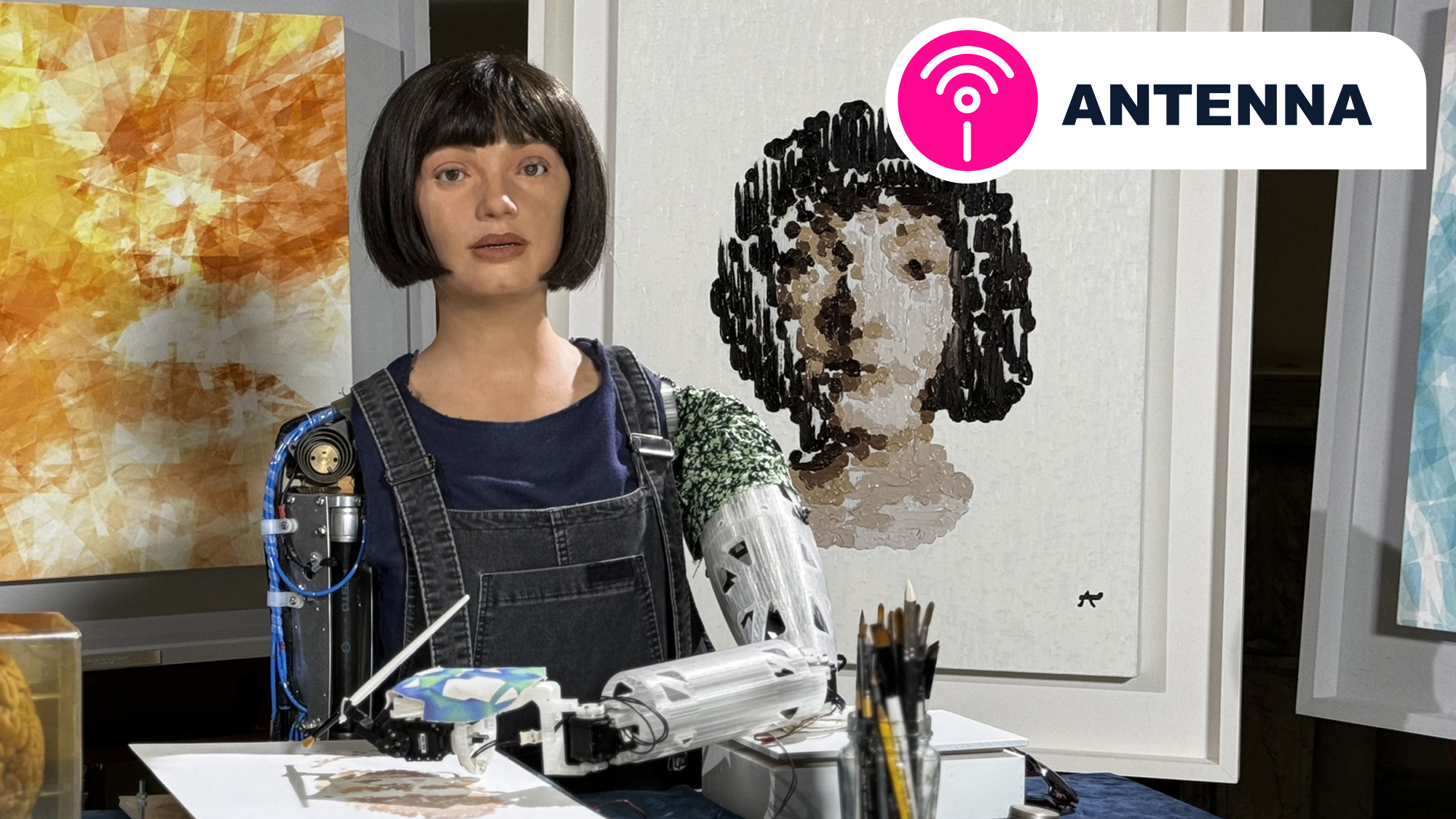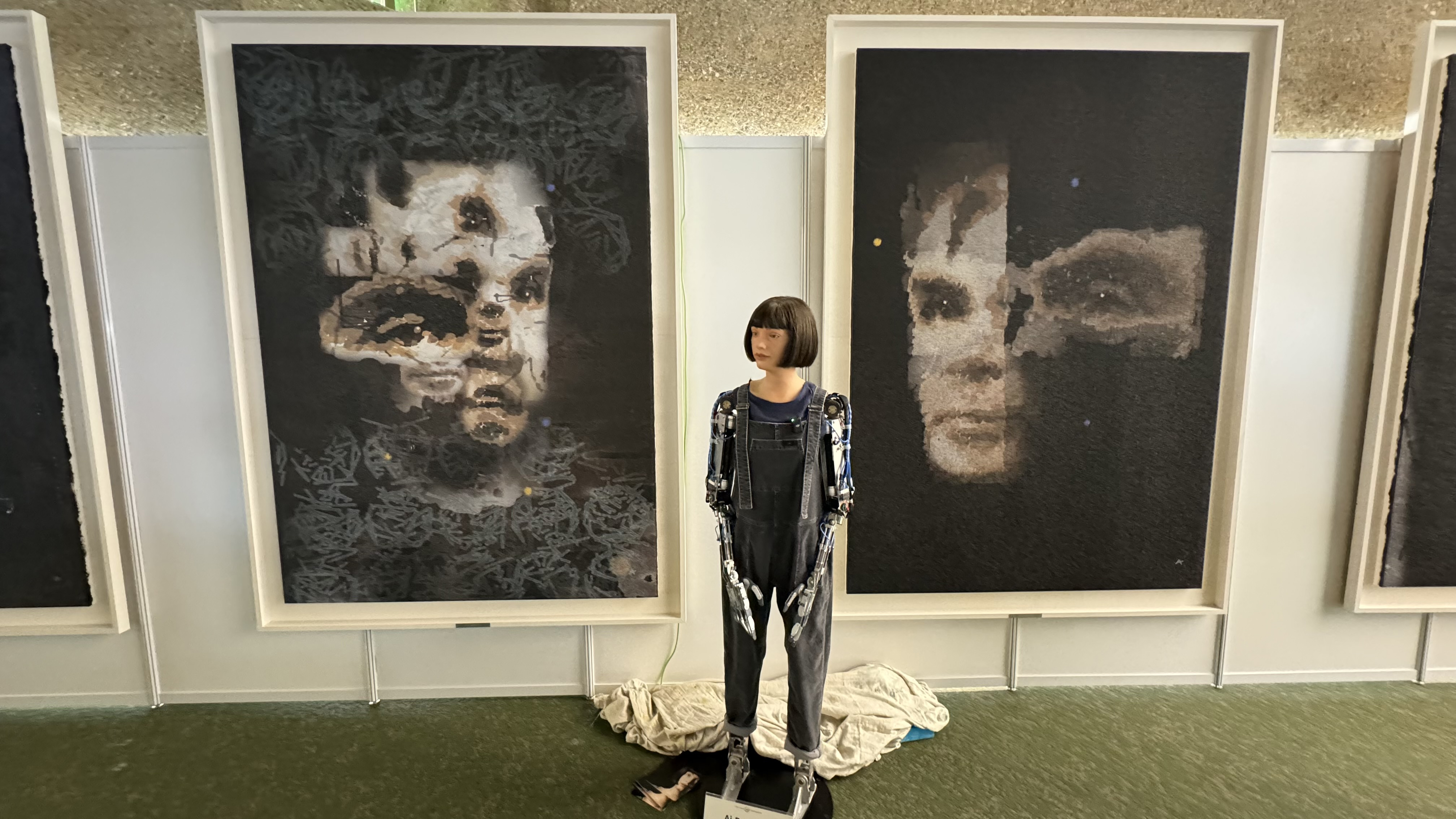
Science fiction promised us robot butlers, but it seems they rather fancy themselves as artists instead. And who can blame them? On November 7, a painting of the mathematician Alan Turing by an AI-powered robot called Ai-Da sold at auction for a cool $1,084,000 (around £865,000). That's a more appealing lifestyle than having to sprint around a Boston Dynamics assault course.
The Sotheby's auction house said Ai-Da is "the first humanoid robot artist to have an artwork sold at auction." It probably also set the record the most online grumbling about a painting, which is understandable – after all, shouldn't robots be sweeping up and making the tea, while we artfully dab at the canvases?

Naturally, the Ai-Da robot and its maker Aidan Meller don't agree that art should be ring-fenced by humans. As Marvin from The Hitchhiker's Guide to the Galaxy once noted: "Here I am, brain the size of a planet and they ask me to take you down to the bridge. Call that job satisfaction? ’Cos I don’t.”
But rather than rely on Douglas Adams to fill in the blanks, we asked Ai-Da and Meller what they'd say to those who are skeptical about AI-generated art – and what the landmark 'A.I. God' painting means for the future of creativity...
The latest 'non-artist'
Ai-Da herself usually prefers to let her art do the talking. When we asked her why she paints her answer was: "The key value of my work is in its capacity to serve as a catalyst for dialogue about emerging technologies".
Fortunately, her creator Aidan Meller, a gallerist and veteran of the art world, was more forthcoming on why team Ai-Da doesn't think the painting or her work should be considered a threat to human artists.
"Contemporary art has always provoked discussions about what art is and Ai-Da and her work is no different," Meller told us. "Just her existence is quite controversial for the art world," he added. Given the reaction to the 'A.I. God' painting, her presence is also pretty controversial for amateur artists, too.
Meller prefers to see Ai-Da as the natural successor to the artistic disruptors of the past. "History is littered with artists that society called “non-artists”. Everyone from Picasso to Matisse challenged people’s idea of what art was during their time. Because it didn’t fit into their conception of what art should be," he told us.
The heart of the project is a robot artist that explores the impact new technologies are having on society.
Aidan Meller, Ai-Da Project Director
"Duchamp challenged the idea of what art could be by putting a urinal in an art gallery and changed the future of art. The Ai-Da Robot challenges the idea of what an artist can be, by creating art using AI technology and creative agency," he added.
But how exactly is AI art created, in Ai-Da's case, and are humanoid robots a necessary part of it gaining mainstream acceptance? After all, there's a difference between hitting the 'create' button in the best AI art generators and seeing a robot physically apply strokes to a canvas.
Who's really holding the brush?
In reality, Ai-Da's work is a collaboration between AI, robots and humans, with the latter still a very necessary part of the process. "We had a discussion with Ai-Da about what she might paint in relation to the concept of “AI for Good”, and she came up with Alan Turing," Meller explained.
"We then showed Ai-Da Robot an image of Alan Turning, which Ai-Da responded to by creating the artwork. She painted 15 images of Alan Turing and then selected three to be combined together to form A.I. God," he added.

Those three portraits were uploaded to a computer and then printed on a canvas, with Ai-Da then applying marks and textures to finish the painting. Some final bits of texture were added by human assistants, in the parts of the canvas where Ai-Da couldn't reach.
The finished artwork has more in common with Warhol's 'Factory' process, then, rather than a decade-long Da Vinci masterpiece. But what does this all mean for the future of art?
The $1 million question
Ai-Da's creator definitely isn't on the side of the AI cynics like Linux founder Linus Torvalds, who recently slammed AI as "90% marketing and 10% reality".
History is littered with artists that society called “non-artists”. Everyone from Picasso to Matisse challenged people’s idea of what art was during their time.
Aidan Meller, Ai-Da Project Director
"I think the response to the painting at auction shows that people understand the importance and power of AI in how it is shaping the world we live in and all of our futures," Aidan Meller said. "The auction shows that AI is on the rise and it is going to change society enormously".
The painting's landmark price tag, which shattered its pre-auction estimate of around around $120,000-$180,000 (£100,00-£150,000) suggests something has shifted in art collecting, too.
"I think it does also mean that the art world is beginning to accept that AI art is here to stay. It also shows that creativity comes in many forms and that AI has the ability to be creative and to add value to the world," Meller added.

That last point is up for debate and will likely remain so indefinitely. The makers of the popular digital art app Procreate, for example, recently said it will never embrace generative AI. In fact, they went a bit harder than that, with CEO James Cuda stating: "I really f***ing hate generative AI. I don’t like what’s happening in the industry and I don’t like what it’s doing to artists."
Clearly, Ai-Da and her process is few steps beyond the basic generative AI we're seeing bolted onto consumer apps, but it could be a tough battle to win over skeptics. Then again, Ai-Da's creator says the point of the robot is to stimulate debate rather than convince you to swap sides...
The 'fourth industrial revolution'
For many, Ai-Da herself is the art story rather than the $1 million painting she co-created. That's something Meller echoed when we asked him why Ai-Da was created in the first place.
"The key value of Ai-Da as a robot artist is not necessarily in acceptance, but in the capacity to serve as a catalyst for dialogue about emerging technologies," he said. Clearly, the art world thinks there's a monetary value in the results produced by the project, but Meller thinks it goes beyond that.

"One purpose of contemporary art is to ask questions of our time and to challenge the status quo, creating debate," he said. "So art created by an AI-powered robot was a good platform to engage audiences into a discussion around the ethical issues surrounding the development of AI technology and our response as a society."
When sat-nav came out, we didn't quite trust it, but now we wouldn't go anywhere without it. AI has infiltrated every part of our lives.
Aidan Meller, Ai-Da Project Director
Ai-Da herself isn't new – we first covered the portrait artist back in 2019 – but the rapid development of AI models has helped transform her skills and make her the face of a hot debate that is sparking controversies on a weekly basis. And Meller admits that Ai-Da is as much as a conduit for debate as an established artist.
"We are currently going through the fourth Industrial revolution, and this is resulting in extreme shifts in both technology and human behavior globally," he said. "So the heart of the project is a robot artist that explores the impact new technologies are having on society".
Art vs sat-navs
The core of the Ai-Da debate revolves around the question of whether there's something unique, even sacrosanct, about art.
For many, art is a communication between humans – the creator and audience – which gives AI-driven art a hollow air of meaninglessness. But Meller disagrees, seeing Ai-Da's approach as the latest development of how humans are using technology.
"Many people look at Ai-Da and think about her being an AI-powered robot, but in many ways humans are becoming more robotic in our use of technology," he said. "We are transferring our decision-making and our agency onto machines, and in lots of ways as humans we are merging with machines and becoming cyborgs ourselves" he observed, pointing to smartphones as the obvious example.
"When sat-nav came out, we didn't quite trust it, but now we wouldn't go anywhere without it. AI has infiltrated every part of our lives, from what work we will do, what news we watch, what kind of partner we have, what kind of baby even we might want to have," he added. "By painting this picture of Alan Turing, Ai-Da Robot is really digging into all of these big ethical issues."
We've been here before
While some will flinch at parallels being drawn between sat-navs and paintings, there's no doubt Ai-Da has succeeded in reviving a debate that's as old as at art itself.
The key value of my work is in its capacity to serve as a catalyst for dialogue about emerging technologies.
Ai-Da
The obvious example is the invention of photography in the mid-1800s, which shocked painters who dismissed the mechanized 'imitation' of their painterly hand as an art form.
Ultimately, photography and art learned to not only co-exist, but to develop a symbiotic relationship. The French painter Degas was influenced by photography, while holding a contempt for the commercialized industry it became. As 'pictorialist' photographers sought to imitate traditional watercolors, painters moved towards impressionism.

Will AI-driven art and human artists do the same, rather than seeking to extinguish each other? History would suggest so. Whatever the financial or artistic merits of the 'A.I. God' painting, it's certainly a lightning rod for debate – and whichever side of the debate you're on, it's one that's worth engaging in.
As the Hungarian artist Laszlo Moholy-Nagy said in the early 1900s, "anyone who fails to understand photography will be one of the illiterates of the future". AI-driven art is clearly here to stay and, while we may eventually get our robot butlers, it'll probably pay to engage with, rather than dismiss, their artistic cousins in the meantime.
You might also like
- World's first permanent museum for AI art is a mind-bending and polarizing concept that fascinates me
- ‘Well the end of aging and death wouldn’t be bad’: Professor who coined the term AGI for superintelligence thinks we’ll get human-level AI in ‘three to five years’
- A Chrome-killing browser will be OpenAI's next big shot at Google, according to a new report







